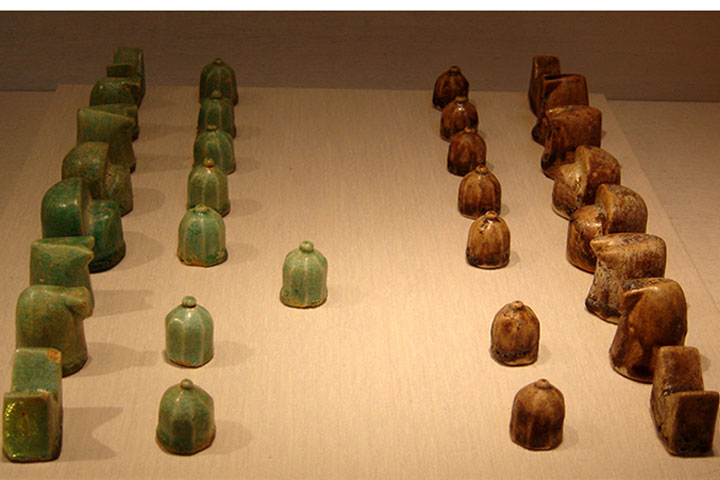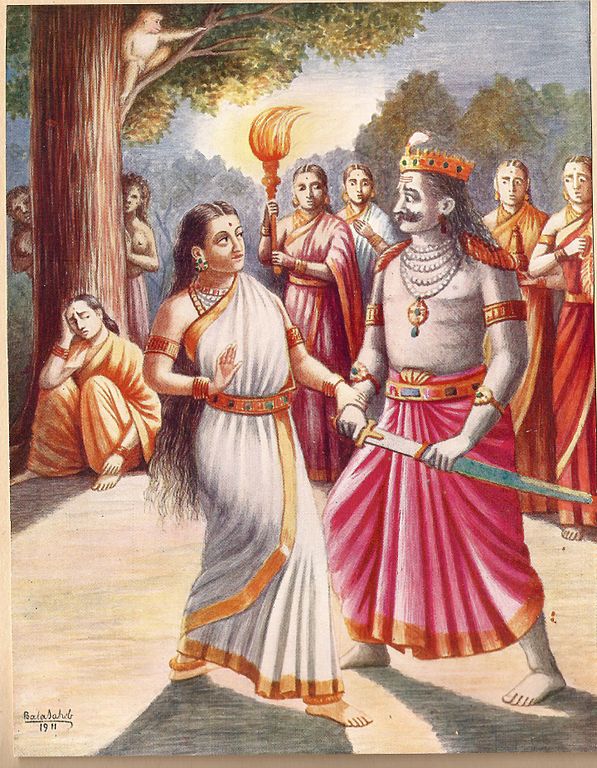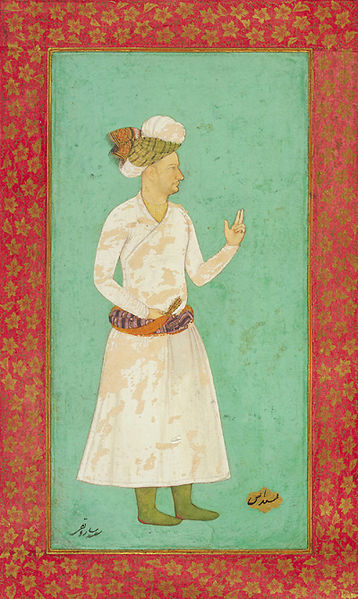


"...and whereas God is worthy of all blessed seriousness, Man (as we said before) is contrived as a kind of ́plaything of God, and this is really the best thing about him; and thus I say that every man and woman ought to pass his life in accordance with this character, playing the noblest forms of play" (Plato, Laws, Book VIII, 803)1
"We are just puppets of fate", the lovely Theresa told me in the twilight of her existence.
We want to know all: what is beyond the infinitely microscopic or what can hide on the stellar depths; if there is a divine plan and the mystery of life; the reasons for the history and the prospects of evolution; if the human being is good and even the possibility that there are multidimensional universes; everything enters into the radar of a mankind always interested in the search for knowledge. Therefore, it is logical to ask ourselves in what moment, in what geographic space, under what authorship, in the context of what culture, chess — the most influential, metaphoric and enigmatic of the pastimes created — made its appearance on Earth.
 When it comes to determining the origin of chess, paraphrasing Marcel Proust, in the search for the exact initial milestone when, as the Argentine and universal Jorge Luis Borges said: "... It was in the East this war took fire./ Today the whole earth is its theatre." The poet, in his unsurpassable work, immediately adds: "Like the game of love, this game goes on forever."2
When it comes to determining the origin of chess, paraphrasing Marcel Proust, in the search for the exact initial milestone when, as the Argentine and universal Jorge Luis Borges said: "... It was in the East this war took fire./ Today the whole earth is its theatre." The poet, in his unsurpassable work, immediately adds: "Like the game of love, this game goes on forever."2
The game of love, in short, that of life; hence the importance in unravelling the first source of chess since it is a real Big Bang that embodies a foundational mystery.
Much research has already been done on this subject. Chess, as a board game, is symbol, myth and rite, more than enough reasons for its connection with such deep values of humanity, to endeavour to know its genesis. Recently, at the same time as new evidence for old hypotheses was obtained, other possible explanations were proposed that could be considered even as novelties. This series of articles will try to make a comprehensive review of all of them, with special attention to the most relevant theories; and mention will be made of others that have been practically abandoned or that correspond to speculations, not based on science or history but representing myths, legends or literary tales.
As an epilogue, after enumerating what we know, what we suppose and what we ignore in this subject, considering the state of the art of research in the matter nowadays, and based on the most verifiable evidence, we will build a holistic vision to explain the origin of chess.
The fact is if one adopts a line in which the prejudices and biased visions are abandoned, considering only the findings based on the scientific evidence, it is very probable that a single explanation can be erected that converges in a common trunk. We believe that it is possible to reach that goal although, we know, there is a wide space yet to be traversed.
Perhaps we're not that far away. When we do solve this issue one could say, as Proust baptized the last of the volumes of his great novel, that we are in the presence of a "time regained", a moment in which we will end up discovering how, when and where chess appeared. Proverbial play in which the will can impose itself on fate.
Numerous theories have been drawn regarding the genesis of chess. Several of them had only the force of legend or myth; or the beauty of the literary imagination, which was often associated with poetry.
 In the foundational myths, the game generally emerges as a model representation of battles in which opponents try to resolve supremacy. Thus it will be for example in the legend that it was invented by the wife of the king of Asuras, Rāvana [pictured in the 1916 book by Ramachandra Madhwa Mahishi], with the idea of distracting her husband with a warlike image, less committed than the real bloody combats, in times when his kingdom was besieged by the god Rama.
In the foundational myths, the game generally emerges as a model representation of battles in which opponents try to resolve supremacy. Thus it will be for example in the legend that it was invented by the wife of the king of Asuras, Rāvana [pictured in the 1916 book by Ramachandra Madhwa Mahishi], with the idea of distracting her husband with a warlike image, less committed than the real bloody combats, in times when his kingdom was besieged by the god Rama.
In the same sense, there is another story originating in India indicating that the game was conceived representing an armed confrontation between the forces of Talkhand and Gav, seeking at once the consolation of Paritchea, the queen who was the mother of both, who was very affected not only because of this struggle between brothers but also because of the death of one of them.
 This specificity in terms of confrontation was highlighted by the Austrian orientalist Frey Paulinus of San Bartholomew [pictured left] who, in the eighteenth century, pointed out that in Indian culture "Brahmins teach youth the science of war through games." On the other hand, in the Chinese tradition, concordantly, it is said that the game was created following an image of an important warlike action that faced two kingdoms, preamble of the constitution of a new empire with the assumption of the Han dynasty in the third century BCE.
This specificity in terms of confrontation was highlighted by the Austrian orientalist Frey Paulinus of San Bartholomew [pictured left] who, in the eighteenth century, pointed out that in Indian culture "Brahmins teach youth the science of war through games." On the other hand, in the Chinese tradition, concordantly, it is said that the game was created following an image of an important warlike action that faced two kingdoms, preamble of the constitution of a new empire with the assumption of the Han dynasty in the third century BCE.
Epic stories, which only demand beauty in their utterance, are contrasted with the rigorous analyses of scientific nature based on history, from which one can construct hypotheses that result from the highest possible degree of verisimilitude. So only these require the strength of evidence and demonstration. The others will remain in the field of persuasion.
Some theories, such as those that posit an original Egyptian or Greek source, had momentarily some force and then lost explanatory power and, one might say, passed from the plane of historicity to that of myth. On the other hand, the one that puts the accent in India, although in some cases relied on epics or legends, ended up decanting as historically very real, prevailing strongly from its first enunciation, although it is by no means an exclusive paradigm. Powerful alternative approaches have emerged that point to a Chinese origin or even to the possibility that the game would have been the product of a process of syncretism with multicultural contributions.
In reviewing the positions of those who hold each of them, it is possible to notice an attitude that is humanly understandable: the generation of, what we might consider, problems of bias. It is often seen that the respective researchers, by explicitly or implicitly (perhaps a priori) adhering to a given position, uncritically magnify the factors that are favourable, ignoring or minimizing the relevance of those others that may be contradictory or conflicting to their own ideas. In addition, they end up ignoring alternative explanations that, in many cases, can provide elements that allow the construction of a broader and univocal hypothesis, by integrating the proven evidence of each position.
This work aims to recreate, with the greatest possible objectivity, the main theses in force about the origin of chess, pointing out their weaknesses and strengths. Rather than ascribing to a specific posture, without preconceptions, each of them will be analyzed taking the elements that are feasible and discarding the improbable, with the purpose of establishing a shared inventory. We base on an implicit assumption: the last word on the issue is not yet said, so it is recognized that there is a vast path to be explored in this quest for truth.
Perhaps we could imagine that we will never know for sure (barring the invention of time-travel) what was that magical moment in which the game appeared on Earth. In any case, in the richness of the diversity of hypotheses raised, we notice an incontrovertible fact: Chess is an object of study of maximum interest, and we are far from being indifferent.
We begin with an initial point of agreement: In the evolution of knowledge, the first undoubted landmark comes with the entry into Baghdad, in the sixth century, a proto-chess from an Indian kingdom.4 From that moment, the progressive sequence of diffusion of the game has been determined, with sufficient precision, through a process of metamorphosis that took it to its present identity.
When the Muslims, a little later, in the second quarter of the seventh century, conquered the territories of the Sassanid Empire, they took the game for themselves and, with slight modifications — in particular to ensure the design of the pieces might not have images which contradict the prohibition of the Qur'an — will be mainly (but not exclusively) responsible for introducing it to Europe in the Middle Ages.
 For it was in Europe that, after a process of incorporation, transformation and systematization, the game would mutate to its modern and definitive form; particularly from the contribution of the Valencian School that introduces the enlarged movements of the bishop and the queen. This is a Western contribution replacing the exotic vizier [right, a 17th century illustration], when a female figure, for the first time, makes its appearance in the game, revolutionizing it both in its format and content.
For it was in Europe that, after a process of incorporation, transformation and systematization, the game would mutate to its modern and definitive form; particularly from the contribution of the Valencian School that introduces the enlarged movements of the bishop and the queen. This is a Western contribution replacing the exotic vizier [right, a 17th century illustration], when a female figure, for the first time, makes its appearance in the game, revolutionizing it both in its format and content.
The vector of further transmission of chess from the moment it entered Baghdad at the hands of an Indian entourage can be traced with absolute clarity. The same happens even if we place ourselves in the other predominant theory, the one that puts a similar primordial source to a model originating in China. What happens is that, under this latter assumption, it is understood that in any case that game expanded to the east and west, including India, so that its propagation channel ends up converging with the axis of the sequence known that goes from this last territory until Persia.
In both cases, we are geographically in the course of the silk road in which, not only goods were transported, but also, of course, people, and with them, elements of travellers' culture, including their main pastimes. Board games, in that context, were useful as distracting elements and had a feature that favoured their inclusion in the caravans: because of their size, they were easily manipulated.
Established precisely in time (sixth century CE) and space (the entry from India to Baghdad), it remains to be seen what happened before with the great game. We move on, to the realm of conjecture. Certainties are left aside, controversies appear and different views coexist. Therefore, we will have to direct the research efforts going back in the chronology, extending the field of analysis to all confines, in order to approach a determination of that mythical foundational moment in which chess appeared.
It is quite understandable that theories about a specific paternity of chess come from direct sources of each culture, beyond the origin of the authors who eventually support it.5 In this process of determination, we appeal, fundamentally, to the chronicles contained in (often epic) stories and, when possible, to the dating of physical findings from archaeological excavations.
In the case of Indian primacy, it is notable that the most conclusive chronicles do not correspond to their own literature, but come from Persian sources. In a rupture of the usual nationalisms, expressions of this last origin recognize that the game was exotic. In saying that the game came from India, the Persians implicitly admit that they were not the inventors. So the looks in principle should be directed to the neighbouring nation. This circumstance, based on concordant written accounts that have been admitted by all the historians in the subject, is the reason why it at least approaches reality — although for epistemological reasons we do not dare to consider that we are in the presence of an absolute truth.6
Thanks to early manuscripts7 in the Pahlavi (Middle Persian) language,8 and other highly influential works of literature in the Middle East9 at the end of the first millennium, such as The Meadows of Gold and Mines of Gems of Al Masudi (896-956) and the Shāhnāma (The Book of kings) of the Persian Ferdousí (935-1020), we know that a proto-chess, the game chaturanga (catur-aṅga, चतुर in Sanskrit), enters Baghdad in the sixth century CE from a region of the northeast, as part of the precious gifts sent to Xusraw I by an Indian Rajah who wished to ingratiate with the mighty King of Kings, who was duly assisted by the wise Bozorgmehr (Burzmihr).

Image of a chess game in Persian culture corresponding to a 14th-century manuscript | Source: Iran Chamber Society
If the Persians, therefore, cannot be considered the parents of chess, according to what is revealed in their own historiography, they will have in turn a decisive role as an agent of diffusion. First, they will appropriate it under the name of čatrang (چترنـــگ in Middle Persian), from which the Arabic šatranj (شــطرنج in Arab)10 will emerge, a moniker which continues to be used until, after experiencing its respective metamorphosis, it will become Western "chess".
In spite of clear evidence of the Persians considering that the game was of Indian origin,11 the researcher Nathaniel Bland, in the 19th century, came to maintain that the paternity could have corresponded to the nation to which it belonged.12 When analyzing an anonymous manuscript, which is not dated (it would have been at least five centuries old and consists of ... sixty-four pages!), it states that chess was invented in Persia, passing then to India and finally returning in an abbreviated and "modern" shape. It refers to two types of game, the conventional and the so-called shatranj Kamil or perfect chess (later known as of Tamerlán or Timur), an extended version that is played in a board of 112 squares and with the presence of 56 pieces. The first would be the Persian, which Bland considers the original; the second is the one that the Indians would send back later (supposedly during the reign of Xusraw I).
A sage named Hakim13 is credited with the invention of that complete chess and there have been various proposals as to how the game is reduced in India, which will make another adviser, the famous Sissa (or Sassa, son of Dáhir) who, in a tradition which has come strongly to nowadays, will require for its invention a reward in cereal grains. The concept of the game was very high considering that it was: "... the nourishment of the mind, the solace of the spirit, the polisher of intelligence, the bright sun of understanding, and has been preferred by the philosopher, its inventor, to all other means by which with arrive to wisdom”.
An interesting point is the religious connotation assigned to it since: "...the board represents the Heavens, in which the Squares are the Celestial Houses, and the Pieces Stars".
Bland, in support of his thesis, pointed out a very interesting fact: the names of the pieces assigned by the Persians remain in other cultures (with slight linguistic corruptions) after the successive stages that they had in their evolution. On the contrary, those originating in India have been definitely forgotten and do not even subsist in the subcontinent.14 Another element that has been used independently to emphasize a supposed Persian primacy is of a geographical nature. It has been argued that when his scribes in ancient times spoke of a Hindu kingdom, in the context of borders that have been so mobile, perhaps the caravans that brought the game from the east could come from a territory that was not India but corresponded to a province the own Persian empire itself (in Khuzestan).
The Spanish researcher Ricardo Calvo,15 for his part, insists on the possibility of an eventual Iranian origin, for which it is based on several arguments, mainly in that the first mentions written are Persian, and not Indian, and in the fact that there are no archaeological finds of pieces of the latter, although they do exist corresponding to Persia. In spite of the foregoing, one must admit that chaturanga is a proto-chess that, therefore, is previous to čatrang. And that's precisely what it's all about: locating the game that, being part of the cycle of cultural diffusion, is one that would have appeared in the previous era.
This approach, as well as in general the problems that we address, connotes an important question: what can be considered chess or in any case proto-chess and what can not? In this respect, some possible interpretations have been designed over time. Without being exhaustive, we could assume that at least the following situations must be verified to consider a given game within this taxonomy:

[Left: Image of a chess of Persian origin that evolved to its Arabic form (shatranj) corresponding to the XII century exhibited in the New York Metropolitan Museum of Art]
Returning to the argumentative line that attempts to place the Persian culture at the beginning of the time segment in which chess has developed, it can be assured that it is very limited since, in addition to not having sufficient explanatory force, it does not affect the other powerful theories that have been held, based in India or China or in the context of a cultural syncretism, all with much stronger empirical evidence and dating much earlier than those offered in the case of the Iranians.
This does not prevent the Persian region from constituting a central point for chess in its process of diffusion and evolution: it is a milestone along the way, an intermediate one, very important indeed, but not the foundational one.
What the Iranians can feel especially proud of is the fact that from their former domains it emerged the nard, a game that is a direct antecedent of backgammon which, by its design, has components that are much more representative of its culture. It reflects with great precision the dualistic cosmogonic concept of Zoroastrianism, a religion that had emerged around the sixth century BCE and was the predominant one in the country. Zoroaster established a divine principle of good, Ormuz or Ahura Mazda, and another of evil, embodied by Ahriman.
The space in which it was practised, symbolizes the sacred Earth, the white and black pieces of the nard represent the days and the nights, the dice refer to the revolution of the planets (there are seven, that is, the sum of the opposite sides of the cubes), the twelve fields of the board allude to the zodiacal signs, the movements of the cards refer to the birth and, in their evolution, respond to the stages of growth in life until death (given at the time of capture); and its reintroduction denotes the possibility of resurrection.
On the other hand, from a political and historical point of view, this ancient Persian game is associated, from its own denomination, nardshir, to Ardashir, to the founder of the Sassanid dynasty, a fact which occurred in the third century CE.

It has been speculated that, having entered chaturanga from India in the four-player game modality, in any case, the Persians would have immediately simplified it to two players, to adequately reflect a strong dilemmatic struggle.
The chess that came from India, then, in its character of image — of war that consequently refers to earthly planes — would not have been the best exponent of the metaphysical values that prevailed in the Persian society during so many centuries of splendour, those values that the nard represented more fully.
References to Nard are found in the Babylonian Talmud dating to around 500 CE | Source: bkgm.com
Continued in part 2...
It is very likely that the reader "ali4110m" is correct in the sense that chess was able to enter Persia by the city of Ctesiphon and not by Baghdad as has always been assured in Western sources based in the translation of the great text of Ferdowsi. Please, if you have more specific references on the matter I ask you to make them known as they will help clarify the issue. Conversely, it could not be concluded that chess was played in Persia in the third century as it actually entered the territory three centuries later, as derived from the Iranian writings themselves and Arab ones (we consulted several sources among which is the Vizārišn ī catrang ud nihišn ī nēvardašēr in an Engish translation). Always these issues are subject to review if new evidence emerges. In addition, already in a less objective terrain, when it is said that the nard is a better representative of the Persian culture than the catrang, that because it reflects more perfectly the idea of duality of Zoroastrianism while the proto-chess is rather seen as a reflection of a choral action in which a battle is represented. (This concept is also discussed later in the document.) For its part, that the nard is interpreted as a better representative of Persian culture than chess does not mean that the latter cannot be as well: There is an idea of pre-eminence and not of exclusion. In addition, the great metaphorical value of our game, facilitated by its greater evolution and its symbolic reappropriation, will make it reflect better than any other pastime, in every place and time, the challenges of humanity. I hope this idea it becomes clear when the text can be read exhaustively.
Regards,
Sergio Negri